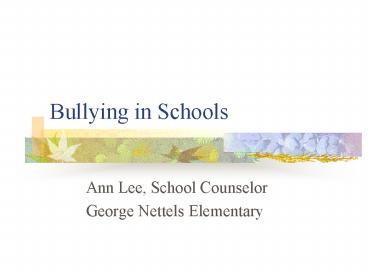Bullying in Schools - PowerPoint PPT Presentation
1 / 14
Title:
Bullying in Schools
Description:
Systematic diminishment of a bullied child's sense of self ... Students have a strong sense of self. Having a friend that will stick with them no matter what ... – PowerPoint PPT presentation
Number of Views:4147
Avg rating:3.0/5.0
Title: Bullying in Schools
1
Bullying in Schools
- Ann Lee, School Counselor
- George Nettels Elementary
2
The bully, the bullied, and the bystander
- It happens everyday in schools
- Bullies terrorize
- Bullied kids are afraid to tell
- Bystanders will watch, participate, or look away
3
How to identify a bully
- Bullying is a conscious, willful and deliberate
hostile activity, intended to harm - Bullying is not about anger, or even conflict.
It is about contempt. - The Bully feels a powerful dislike for someone
the bully considers to be worthless, inferior, or
undeserving of respect.
- Contempt allows bullies to harm others without
feelings of empathy, compassion or shame
4
A bully believes he/she has
- A sense of entitlement-the right to control,
dominate, and abuse another human being - An intolerance toward difference
- A liberty to exclude-to bar, isolate, and
segregated a person deemed not worthy of respect
5
3 Types of Bullying Situations
- Verbal Bullying
- Most common type of bullying
- Easy to get away with (can be whispered in
presence of adults and peers without detection) - Ex. four eyes, big nose, geek, queer,
fag
6
Types of Bullying
- Physical Bullying
- Accounts for less than one-third of the bullying
incidents reported by children - Ex. Slapping, hitting, chocking, poking,,
punching, kicking, biting, pinching, scratching,
twisting limbs into painful positions, spitting,
and damaging or destroying clothes and property
belonging to bullied child.
- Relational Bullying
- The most difficult to detect from outside
- Systematic diminishment of a bullied childs
sense of self - Used to alienate and reject a peer or to
purposefully ruin friendships. - Ex. Aggressive stares, rolling of eyes, sighs,
sneers, snickers, spreading of rumors,
isolateing, ignoring, shunning.
7
The warning signs of the bullied.
- Shows an abrupt lack of interest in school, or
refuses to go to school - Takes an unusual route to school
- Suffers a drop in grades
- Withdraws from family and school activities
- Is hungry at school
- Steals money from home
- Makes a beeline to the bathroom when arriving
home - Is sad, sullen, angry, or scared after receiving
a phone call or email - Does something out of character
- Has stomachaches, headaches, panic attacks, is
unable to sleep, sleeps too much - Plays alone or prefers to hang with adults
8
Why kids dont tell
- They are ashamed of being bullied
- They are afraid of retaliation
- They dont think anyone can help them
- Theyve bought into the lie that bullying is
necessary to growing up - They think they are tattling
- They believe that adults are bullies too
9
The bystander
- How are they involved?
- They aid the bully through acts of omission and
commission - They stand idly by or look away, or they can
actively encourage the bully or join in.
- As a teacher, you encourage the bystander to
change their role. - Bystanders become active witnesses, stand up for
their peers, speak out against injustice
10
As a teacher, what dont you do?
- Do NOT minimize, rationalize, or explain away the
bullying behavior. - Dont rush in to solve the problem for the child.
- Dont tell the child to avoid the bully.
- Dont tell the child to fight back.
- Dont confront the bully or the bullying parents
alone.
11
How do you help a child being bullied?
- Tell the student, I hear you I am here for you
I believe you you are not alone in this. - Reassure the child it is not their fault
- During investigation, talk with each participant
individually. - Document, document, document
- Follow school discipline plan
- Involve principal and counselor
- Notify all parents involved
12
Powerful antidotes to bullying
- Students have a strong sense of self
- Having a friend that will stick with them no
matter what - Being able to successfully get into a group
- Students get out of a group when it doesnt serve
them well
- In the classroom, a teacher would
- Nurture empathy toward others
- Have a strong set of classroom rules
- Teach friendship skills
- Teach students to encourage positive
relationships - Encourage students to be a witness not a
bystander to bullying
13
Reference
- Coloroso, B. (2003). The bully, the bullied, and
the bystander From preschool to high school
how parents and teachers can help break the cycle
of violence. New York, NY HarperCollins.
14
(No Transcript)































